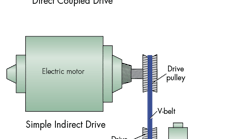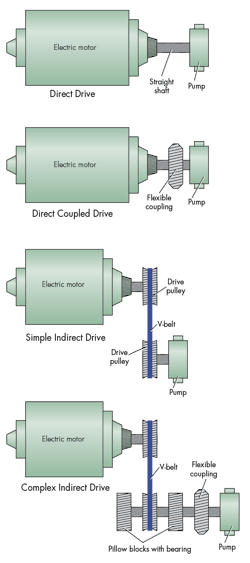What’s the Difference Between Direct and Indirect Drives for Hydraulic Pumps?
Engineers and designers commonly use electric motors to power hydraulic pumps. In some cases, the motor and pump are set up in a direct drive configuration. In others, they are connected using an indirect drive. Here’s a look at each drive type.
Direct drives consist of a shaft connecting a motor and pump. They are inexpensive, simple, and eliminate all side loads on the pump bearings. But direct drives are still only applicable to a small number of applications. That’s because the pump and motor must be rigidly and accurately mounted to ensure alignment of the pump and motor shafts. The pump may require a pilot surface to mate with a pilot bore on the mounting pad. Even with piloted surfaces, technicians must be extremely careful with the alignment during installation.
For some applications, a set of matched pumping elements can be mounted on an overlength motor shaft to ensure proper alignment. The finished setup resembles an integral pump-motor.
If there’s a flexible coupling between the shaft and pump, it is called a direct coupled drive. This is one of the most common ways to drive a pump. It has most of the benefits of a direct drive, but eliminates the need for precise shaft alignment. Side loads on the bearings are usually low, but proportional to the misalignment with some coupling types, and the drive is simple.
Couplings generally used in this type of drive should accommodate the angularity of intersecting shafts, as well as offset or nonintersecting shafts. Coupling backlash or “windup” is generally not an issue.
Indirect drives use gears, pulleys, or chains to offset the motor shaft from the shaft turning the pump, providing the obvious advantage of being able to adjust the speed or rpm level of the pump shaft. Indirect drives can be configured to yield almost any motor/pump speed ratio. Thus, a pump can be driven at an unusual speed by a standard motor. Or a shaft turning at some odd speed can be adapted to pump-drive duties through the appropriate indirect drive.
On the downside, indirect drives use more components, adding complexity and cost. They also require more space and can cause excessive side loads on the pump shaft.
Simple indirect drives, in which the driving pulley or gear mounts directly on the pump shaft, creates the highest side loads. To minimize these loads, the driving member should be placed as close on the shaft to the pump as possible. Using the largest practical gear or pulley also minimizes bearing loads.
Complex indirect drives almost completely eliminate side loading by using a flexibly coupled shaft supported by their own bearings. This confers all of the advantages of an indirect drive while avoiding destructive side loading. Because of the separate pillow blocks, shaft, coupling, and drive components required, these are the most complex of all pump drives.

